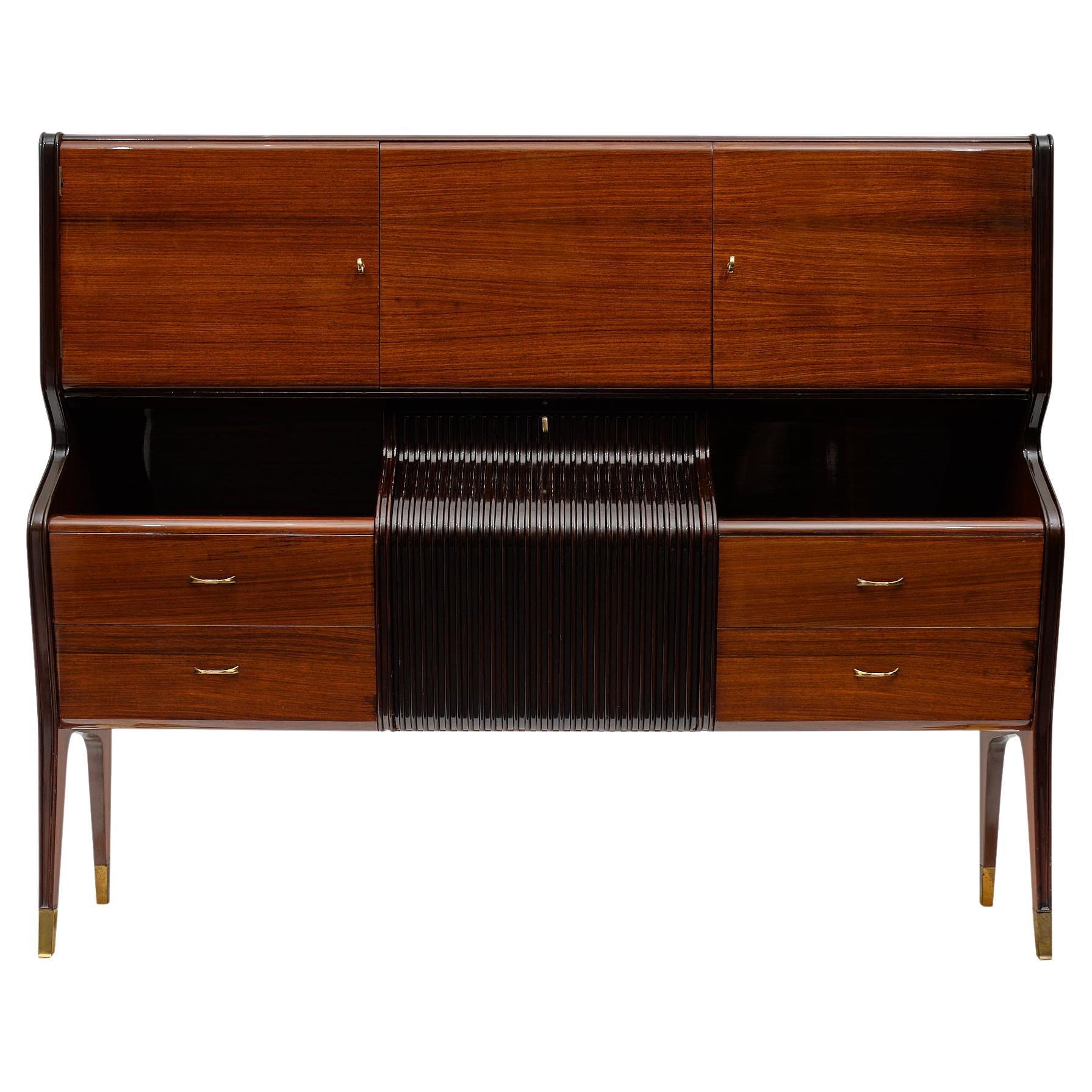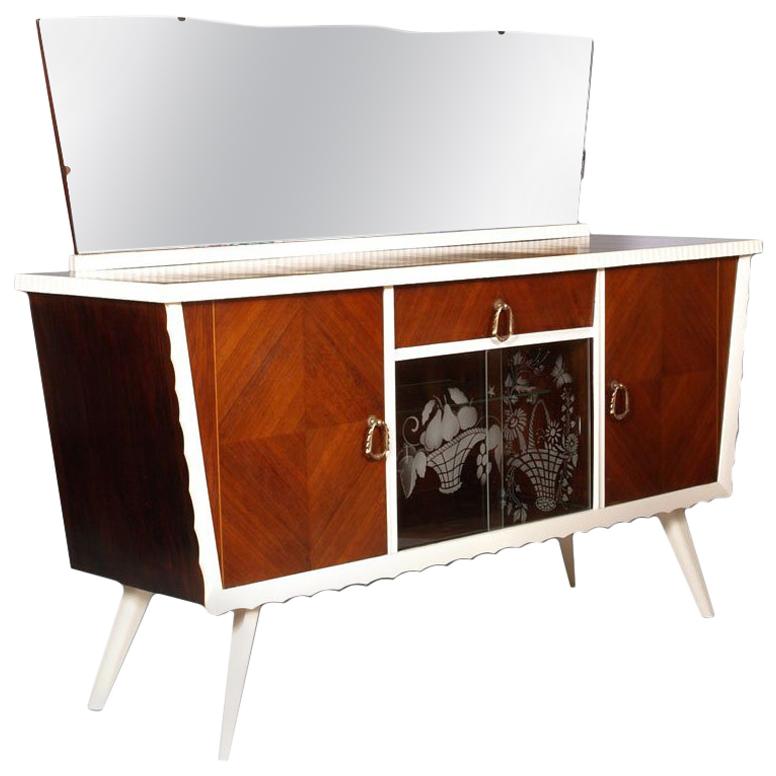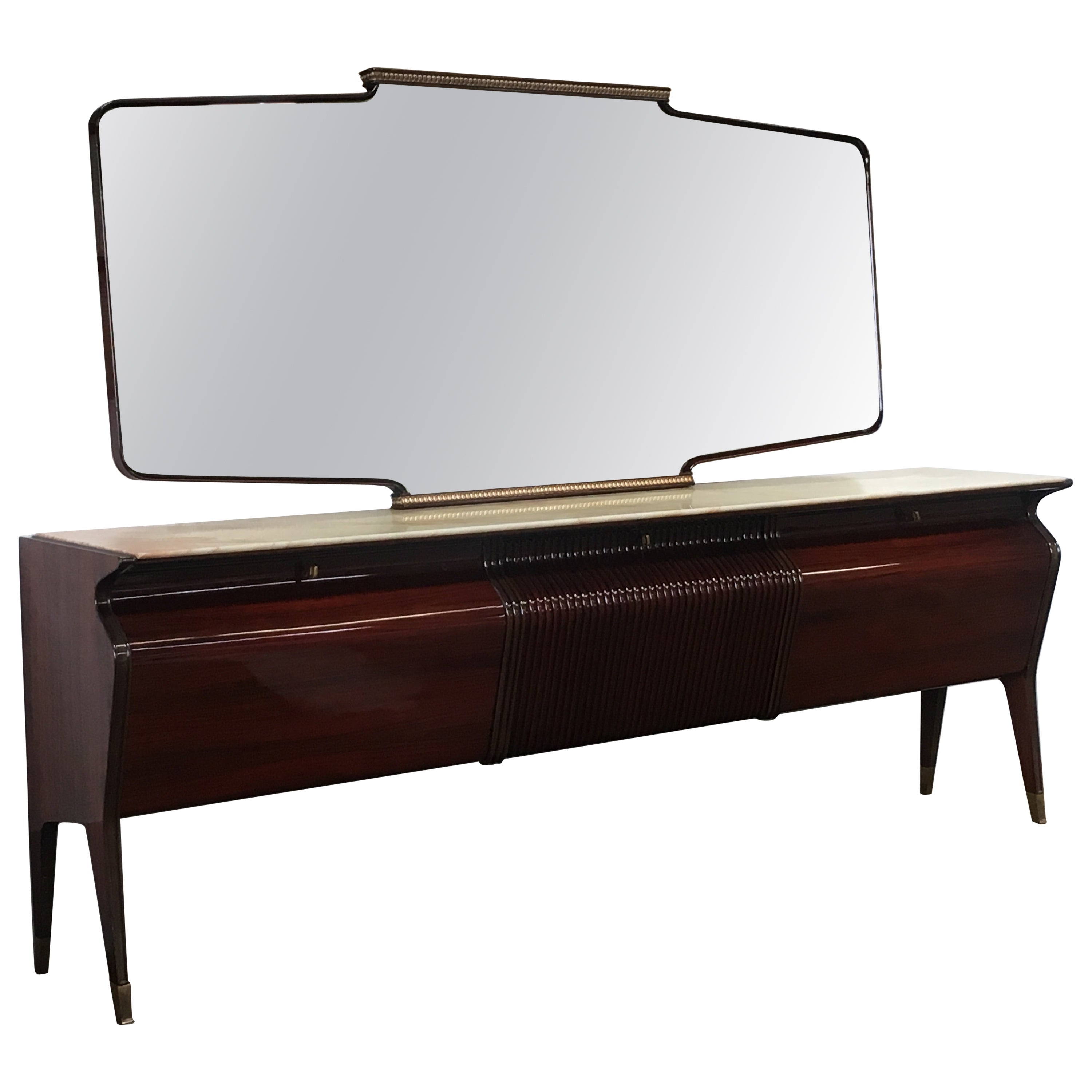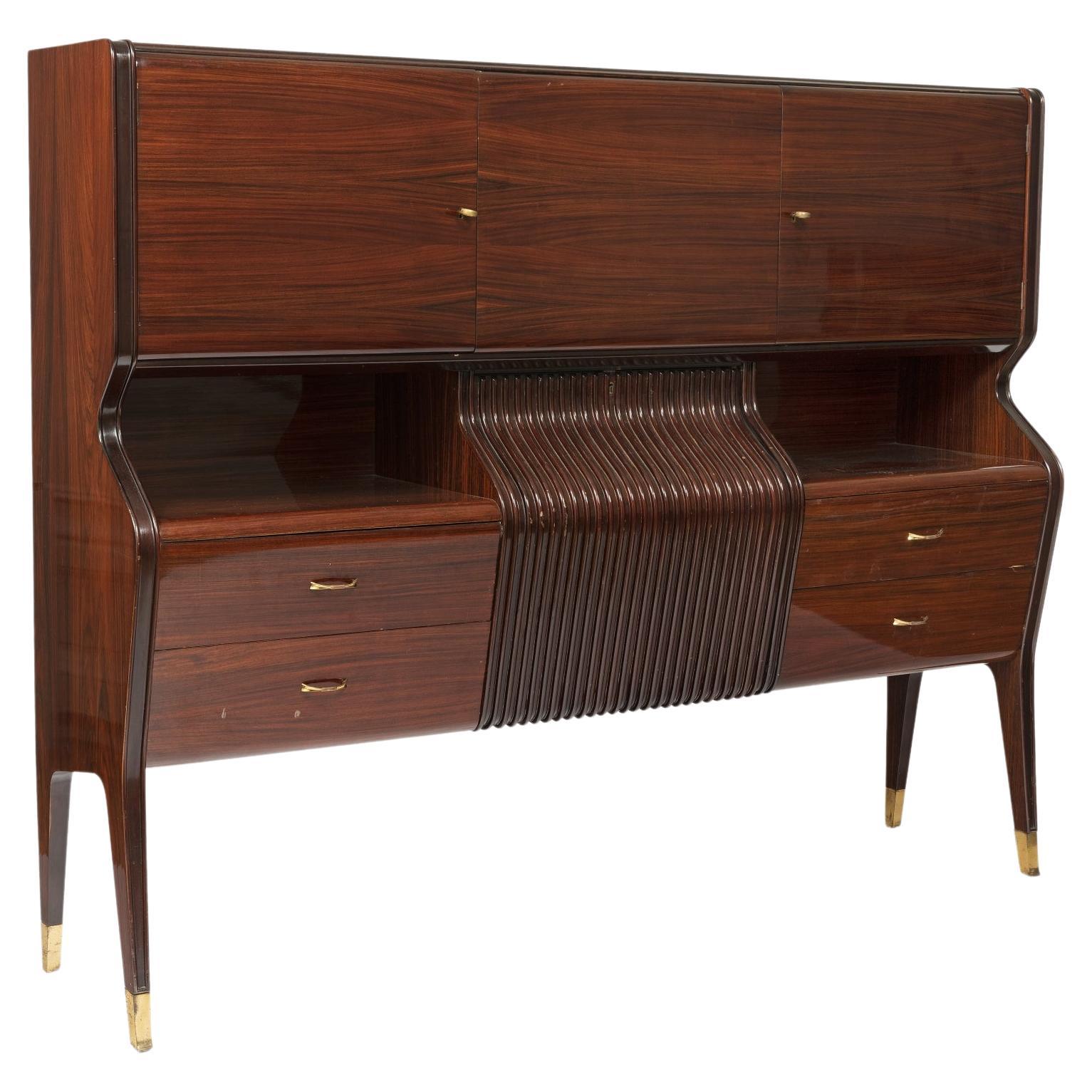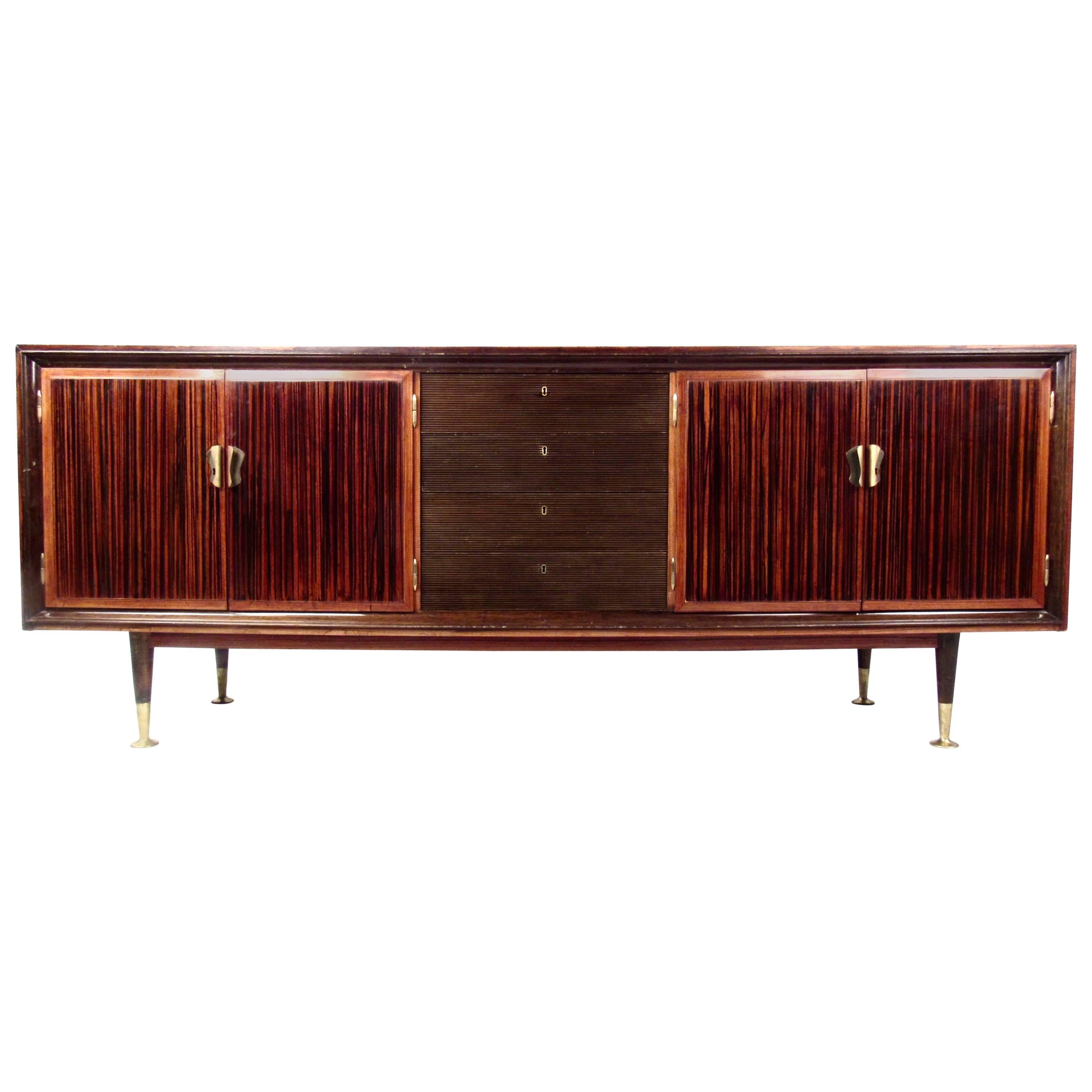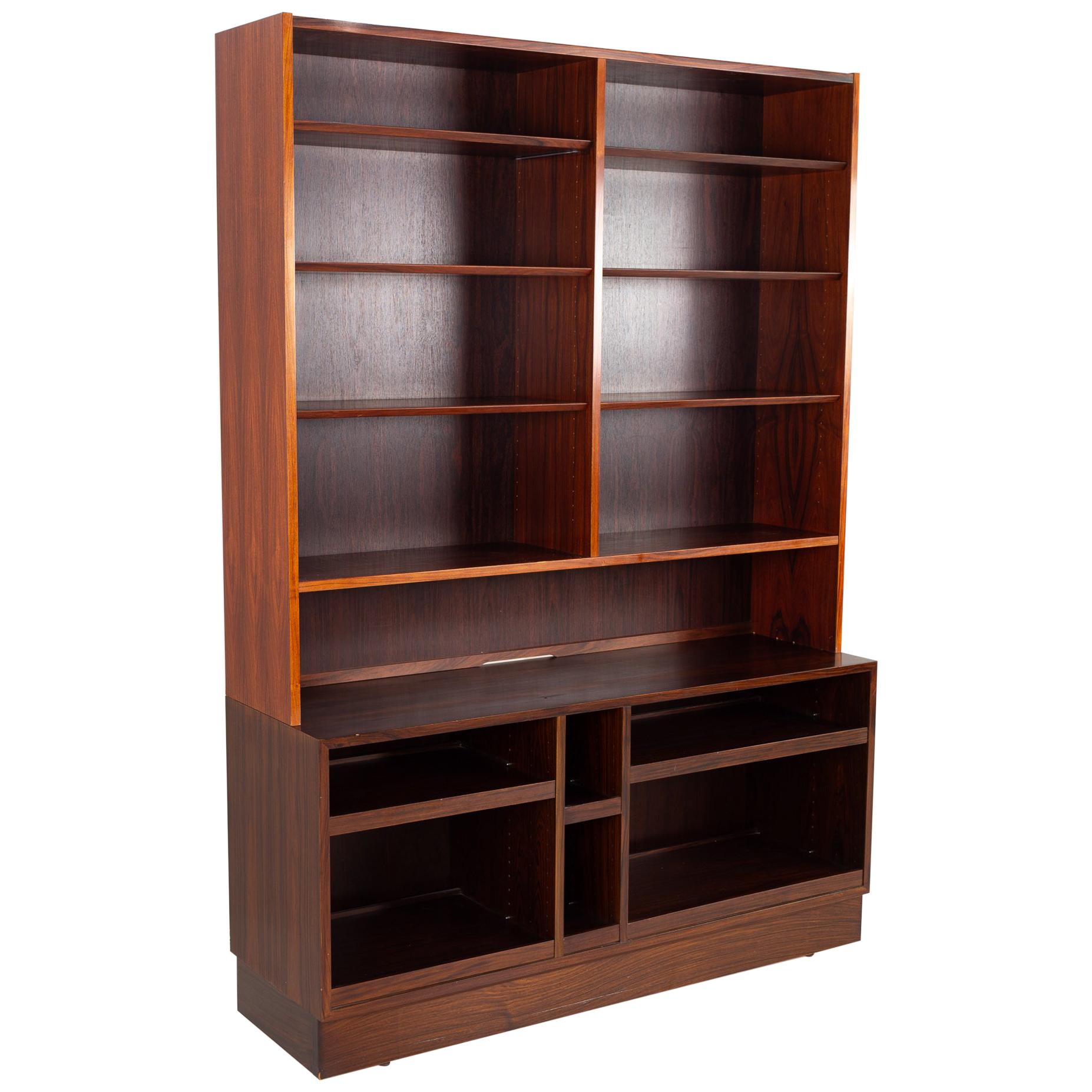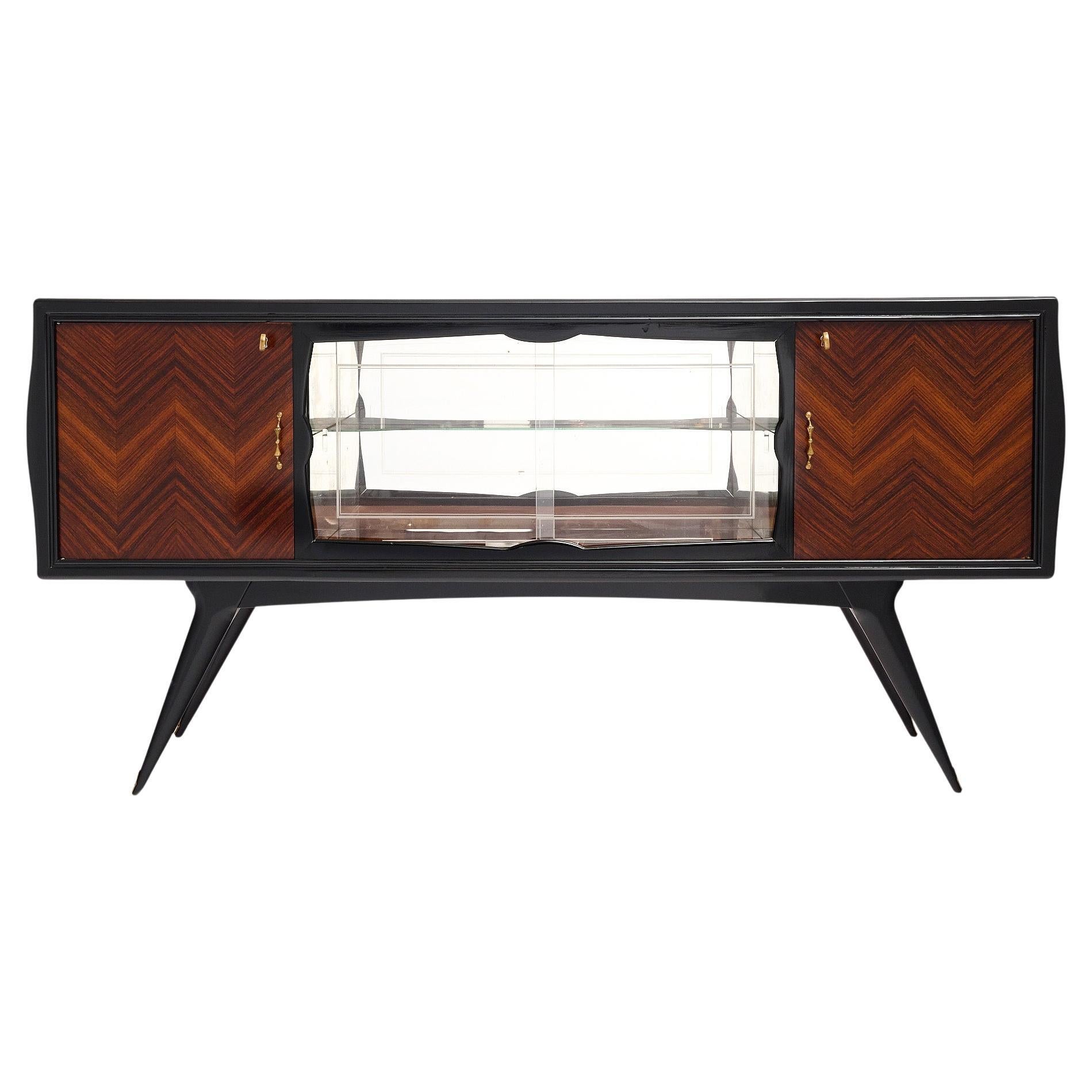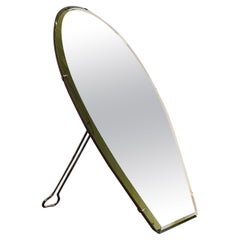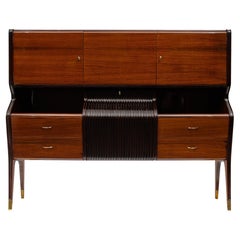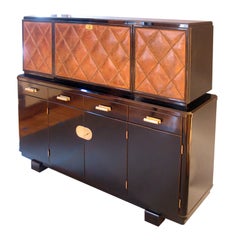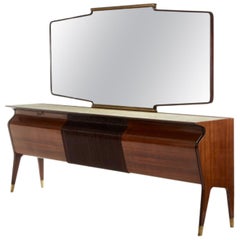
Osvaldo Borsani Rosewood Buffet with Large Mirror Borsani Arredamento Production
View Similar Items
Osvaldo Borsani Rosewood Buffet with Large Mirror Borsani Arredamento Production
About the Item
- Creator:Osvaldo Borsani (Designer)
- Dimensions:Height: 77.17 in (196 cm)Width: 108.67 in (276 cm)Depth: 19.69 in (50 cm)
- Style:Mid-Century Modern (Of the Period)
- Materials and Techniques:
- Place of Origin:
- Period:
- Date of Manufacture:Unknown
- Condition:Wear consistent with age and use.
- Seller Location:Montecatini Terme, IT
- Reference Number:1stDibs: LU5304219348121
Osvaldo Borsani
With his stylish and technically innovative furniture, Osvaldo Borsani helped change the face of Italian design in the 1950s and ’60s. His sofas and chairs, featuring deeply upholstered seating and adjustable position settings, have an aura of optimism and efficiency that still seems fresh and lively today.
Born in the commune of Varedo in northern Italy’s Lombardy region, Borsani studied at the Brera Academy in Milan — the same school attended by such luminaries as designer Piero Fornasetti and artist Lucio Fontana — as well as the Polytechnic University of Milan. Borsani first worked for his father’s furniture-making firm, Arredamenti Borsani, an atelier influenced by the more expressive and curvaceous wing of Art Deco design. By 1953, when, along with his twin brother, Fulgenzio — the pair also created this visionary mid-century villa — Borsani opened the furniture company Tecno, his design sensibilities had evolved toward furnishings with strong, simple forms enhanced by mechanical innovations, as with the P40 adjustable armchair (1953). Borsani would be the firm’s lead designer for 30 years, while fostering work by Vico Magistretti, Carlo di Carli, Robin Day and others.
Similar to Gio Ponti in the earliest years of his career, Borsani first created designs marked by lush and buoyant lines: tables with voluptuous curved legs, sofas with undulating backrests. But Borsani’s best-known and most novel pieces date from Tecno’s initial furniture lines: the adjustable D70 sofa, which folds open to make a daybed, and the P40 recliner. The latter — now included in the collections of the Museum of Modern Art and the Victoria & Albert Museum — is an articulated lounger with a back, seat and leg rest that can be moved into 486 different positions. Not only is it extremely comfortable, it is also enduringly chic.
Find a collection of vintage Osvaldo Borsani tables, dining chairs and other furniture on 1stDibs.
- Pier Luigi Colli Large Sideboard in Wood with Drawers Italian Manufacturer 1930sBy Pier Luigi ColliLocated in Montecatini Terme, ITLarge sideboard is entirely realized in oak wood, with four drawers on each side (for a total of eight drawers) and a central storage unit. Designed by Pier Luigi Colli Italian Manufacture from 1938 ca. To reconstruct the story of Pier Luigi Colli, we must take a leap back to the 19th century in Turin, a multifaceted city, in some ways controversial due to its austere and sometimes introverted character, but at the core of a creative drive: and if it is primarily known for its automobile industry, there was a time when Turin was at the height of fame also in the field of furniture and embroidery, thanks to the presence of two entrepreneurial realities. On the one hand there was the MIRAM (Italian Hand-Made Embroidery Manufacture) founded by Pietro Colli in 1850, specializing in gobelin fabrics and bandera embroideries. His daughter Teresa traveled between Italy and Paris to discover the latest trends in fabrics and embroidery, while her younger brother, Pier Luigi Colli (1895-1968), the star of this story, joined the company in 1921. Distinguishing himself for his enterprising personality and willing to continue his father's profession, Pier Luigi was known to his contemporaries as "the artist interior designer", and had no doubts about his future: he moved temporarily to Paris, where he attended L'Ecole des Beaux Arts Décoratives. The other great Turin manufacturer to be mentioned is Martinotti, founded in 1931 by Giuseppe Martinotti and supplier of fine furnishings for the Savoy court, pieces which were characterized by a typically 19th century eclectic style, generally made of exotic woods featuring ivory and tortoiseshell inlays: at that time, Martinotti represented the top of internationality, having even participated in the 1875 Philadelphia exhibition! The two brands' fate merged in 1902, a decisive year for Turin which, hosting the International Exhibition of Modern Decorative Art, became the cradle of the spread of the Liberty style in Italy. In the exhibition, Martinotti exhibited an elegant interior, in which all the textile parts, from the curtains to the seat upholstery, was made by Colli. It was in 1926 that Colli (MIRAM) finally acquired Martinotti, founding a laboratory where, from the savoir faire of the two companies, complete pieces of furniture were created and tailor-made for the customer, from the structure to its upholstery. Meanwhile, Pier Luigi Colli was living in Paris, the ideal place to be in 1925, when the International Exhibition of Modern Decorative and Industrial Arts brought him closer to the work of one of his putative fathers, the great French cabinet maker Jacques-Émile Ruhlmann (Paris, 1879 - 1933). Thanks to Paris, Pier Luigi intertwined contacts with the international beau monde, he started to import Lalique glass from France, while the Colli's clientele expanded and special commissions arrived, such as the creation of the Royal Train of the Savoy family made with Fiat, or the lecture hall in the University of Turin. The success of a brand is also measured by its openness to establishing collaborations with the great designers of its time, in the case of Colli resulting in important creative partnerships: from Gio Ponti, who relied on the brand for his Richard Ginori project in Rome, up to Carlo Mollino, who created with Colli the handrails of the RAI (national TV) auditorium and the windows of the Teatro Regio in Turin; also in Turin, the Morbelli architects collaborated with Colli for the furnishings of the RAI skyscraper, and the architects Gabetti Isola for the interiors of the Stock Exchange in Turin. In the 40s and 50s, having opened a branch in Rome, Colli was at the peak of productivity. The embroidery and textile section continued to be one of its strengths, keeping alive the relations with France and its great masters: among the inspirations were the geometric shapes of the fabrics of Ruhlmann's interiors, or the tactile carpets made by designer Mariod Dorn. And so, another Colli trademark become the "textured carpet...Category
Vintage 1930s Italian Mid-Century Modern Sideboards
MaterialsWood, Oak
- Sergio Mazza Set of Two Narciso Wall Mirror with Brass Frame by Artemide 1960sBy Artemide, Sergio MazzaLocated in Montecatini Terme, ITSet of two round-shaped wall mirror model Narciso with frames in brushed nickel-plated brass and mirrored crystals. The Narciso mirror can be mounted on the wall thougth the chai...Category
Vintage 1960s Italian Mid-Century Modern Wall Mirrors
MaterialsCrystal, Nickel, Brass
$1,307 Sale Price / set20% Off - 20th Century Vanity Mirror in Crystal and Wood by Tenca & C ItalyLocated in Montecatini Terme, ITA lovely vanity or table mirror of the early 20th century, designed and produced by the glassmaking company fonuded in 1881 in Milan by Carlo Tenca. The mirror present the manufactu...Category
Early 20th Century Italian Mid-Century Modern Table Mirrors
MaterialsMetal
- Emilio Lancia Large Sideboard in Walnut Wood Italian Manufacture 1930sBy Emilio LanciaLocated in Montecatini Terme, ITA mid-century sideboard with structure in walnut veneer with brass details, the sideboard presents three doors and six inner shelves. Designed by Emilio Lancia, Italian manufacture ...Category
Vintage 1930s Italian Mid-Century Modern Sideboards
MaterialsBrass
- Gio Ponti Large Green Vase in Ceramic by Richard Ginori 1930s ItalyBy Gio Ponti, Richard GinoriLocated in Montecatini Terme, ITLarge vase in green ceramic designed by the Italian designer Gio Ponti and manufactured by Richard Ginori between the 1930s and the 1940s. In this piece, the ceramic was modeled with an elegant and raffinate, flared shape that makes it a perfect decorative vase. The manufacturer's brand is stamped under the base. The history of the Ginori Manufactory began in Doccia, just a stone's throw away from Florence, when in 1735 Marquis Carlo Andrea Ginori started a porcelain factory which was destined to become a worldwide icon of style. The eighteenth-century is a key century for the development of porcelain in Europe, in this period the first manufactures are born, fed by new styles and international trends. In stately homes, palaces and courtyards, the precious porcelain of the Doccia Manufactory is synonymous with elegance and refinement. The passage from the nineteenth, the century of reason to that of feeling marks a new chapter in the development of artistic taste and the manufacture of porcelain. Florence becomes the scene of a controversy between the academic supporters of the Beautiful ideal and the naturalists promulgators of the beautiful natural Since 1806 the direction of the Manifattura passed to Leopoldo Carlo Ginori Lisci who initiates a process of profound renewal. In 1986 The Manifattura expanded and the Richard Ginori Ceramic Company is born. The tradition of master craftsmen meets new technologies and the creations are perfected thanks to the use of new patents From 1923 to 1933 the artistic direction of the Manifattura was entrusted to Gio Ponti. The master is responsible for introducing highly innovative elements with sensitivity and respect for the taste for the ancient, and for the oriental culture. In 1925 at the Universal Exposition in Paris, the Manifattura and its artistic director were awarded the assignment to both of a Grand Prix. The Manufactory was renewed by relying on the experience of the greatest Italian designers of the time: Franco Albini, Franca Helg, Antonio Piva, Sergio Asti, Achille Castiglioni, Gabriele Devecchi, Candido Fior...Category
Vintage 1930s Italian Mid-Century Modern Vases
MaterialsCeramic
$3,050 Sale Price41% Off - Stilnovo Chandelier with Lampshades in Opaline Glass Italian Manufacture 1970sBy StilnovoLocated in Montecatini Terme, ITChandelier with three lampshades in opaline glass and a structure in enameled and nickel-plated metal. Manufactured by Stilnovo in 1970s Italy. Stilnovo was an important lighting c...Category
Vintage 1970s Italian Mid-Century Modern Chandeliers and Pendants
MaterialsMetal
$871 Sale Price20% Off
- Osvaldo Borsani Buffet with BarBy Osvaldo BorsaniLocated in Austin, TXItalian rosewood buffet and bar by Italian designer Osvaldo Borsani. This fine cabinet features a mirrored and tinted glass upper compartment behind folding doors, on the bottom four...Category
Vintage 1960s Italian Mid-Century Modern Buffets
MaterialsGlass, Rosewood
- Buffet or Bar by Osvaldo BorsaniBy Osvaldo BorsaniLocated in New York, NYVery rare piece by Osvaldo Borsani with original leather and interior pink paint.Category
20th Century Italian Art Deco Buffets
MaterialsBronze
- Midcentury Osvaldo Borsani attributed Credenza Buffet in Walnut and MahoganyBy Osvaldo BorsaniLocated in Vigonza, PaduaMid-Century Modern credenza buffet, in walnut lacquered and mahogany veneer with engraved sliding glass. Circa 1930. Also available without mirror Measure cm: H 85+48, W 160, D 47.Category
Mid-20th Century Italian Mid-Century Modern Buffets
MaterialsGlass, Mahogany, Walnut
- Italian Modernist Buffet in the style of Osvaldo BorsaniBy Osvaldo BorsaniLocated in Austin, TXGrande buffet, credenza, Italian, of rosewood finished in a lustrous French polish, in the style of iconic designer Osvaldo Borsani, the rounded side board boasts five doors opening ...Category
Vintage 1960s Italian Modern Buffets
MaterialsMarble, Brass
- Mid-Century Modern Italian Mahogany Sideboard with Mirror by Osvaldo BorsaniBy Osvaldo Borsani, Fratelli TurriLocated in Prato, ITMid-Century Modern Italian mahogany sideboard with onyx top and mirror by Osvaldo Borsani for "Mobilificio Fratelli Turri", 1950s The mirro...Category
Vintage 1950s Italian Mid-Century Modern Buffets
MaterialsBrass
- Bar En Palissandre D’Osvaldo BorsaniBy Osvaldo BorsaniLocated in Bruxelles, BEMeuble Bar d’Osvaldo Borsani en palissandre, verre et miroirs, embouts et poignées en laiton. Issu de la période avant sa collaboration avec Tecno, on retro...Category
Vintage 1950s Italian Dry Bars
MaterialsPalisander, Glass
Recently Viewed
View AllRead More
Mid-Century Master Osvaldo Borsani Gets His Due at Donzella
The New York City gallery has devoted its latest show to the work of the modernist Italian designer.
Peek inside Osvaldo Borsani’s Mod Italian Villa
The iconic mid-century estate outside of Milan opens its doors to the public for a very special homage.
